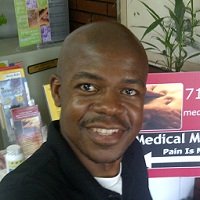How to Become a Medical Massage Therapist

Cameron Richards is a medical massage therapist at Medical Massage Clinic in Flushing, New York. Cameron studied massage therapy at New York College of Health Professions and has been a medical massage therapist for the past four years. His own personal experience with medical massage led him to pursue this career.
After an automobile accident, Cameron began to suffer cervical issues and frequent headaches that debilitated him. His doctors recommended steroid injections, but Cameron hoped to avoid drugs; he sought out chiropractic care and medical massage instead, and finally found relief. After this experience, he opened Medical Massage Clinic because he wanted to help others who also desired an alternative to drugs and surgery. Cameron’s experience in the medical massage field has been challenging, but he also finds it incredibly enriching and fulfilling.
What is a medical massage therapist?
A medical massage therapist is trained to identify abnormally tense and rigid soft tissue such as muscle, ligaments, fascia, and the articulations of the body and then apply a scientifically based system of corrective techniques. The therapist will focus the medical massage treatment only on the areas of the body related to the diagnosis and prescription from the client’s doctor. In order to perform medical massage, the massage therapist must always be licensed in his or her particular state, and have met the required educational standards of that particular state.
Why did you decide to become a medical massage therapist?
I wanted something different from the traditional spa environment. The goal of a spa is pampering and relaxation. I wanted something that would challenge me and in the meantime help people who are suffering from chronic pain and other musculoskeletal disorders.
Are there common misconceptions about your profession?
Unfortunately, yes. There are still a large percentage of the population that has yet to experience massage and reap the benefits. Some of these people feel they cannot afford a session. Some medical professionals do not believe in what we do, and they would label us as quacks. Sometimes they tell their patients not to seek massage. However, times are changing and many medical professionals are now being forced to become educated on the benefits of therapeutic massage. Their patients will seek alternative treatment to drugs and surgery, then return for their follow-up only to advise their doctor of how massage had helped them tremendously.
What is a typical day like for you?
A typical day at the clinic starts off with clients coming in and filling out their intake forms. These forms are somewhat similar to what a person will fill out when they are visiting their doctor. However, the forms are a bit more involved. When these forms are completed, we go over the intake forms with the client. We then formulate the best treatment plan that will benefit the client. After a client session, they are sent home with an after-care packet.
In this field, there is a lot of charting, especially if it is an insurance case. We keep a filing system on every client that comes in for service. After a session, a client file is then transformed to our computer data base where we build a file for them. We create SOAP notes and book return appointments.
A typical workday is about six hours. This typically includes three to five bookings per therapist. A normal workweek is about 35 hours with around 15-25 clients.
What are your favorite aspects of your job?
My favorite aspect of the job is meeting and helping people who are stressed or chronically in pain return to an active life. They are coming to me for help and guidance, and seeing them leave feeling much better than when they first walked in is a feeling of success.
What are your least favorite aspects of your job?
The least favorite aspect of the job is when a client leaves and feels the same as when he had entered.
Is there anything you would have done differently while studying to become a medical massage therapist?
I would like to have focused more throughout my studies on the medical aspect of massage. I would have become involved in more case studies and hands-on projects.
What classes did you take in college that are the most relevant to your job?
In college we were given two trimesters of medical massage, anatomy and physiology, and myology courses, as well as a semester of kinesiology. They were very helpful and required a lot of studying.
What personality traits do you think would help someone to be successful as a medical massage therapist?
You have to be patient and you have to be a people person. You should also be detailed and love researching and solving issues. You must be open-minded, and always willing to learn new things relating to your field.
What personality traits do you think might hinder someone's success as a medical massage therapist?
Not studying daily, procrastination, or just being too busy to read and broaden your knowledge will impact one's ability to be successful in this field.
What advice, or words of caution, would you give to a student who is considering studying to become a medical massage therapist?
Be patient and learn all you can. Surround yourself with people who are in the industry. They would be happy to guide you as long as they see you are serious. Keep things simple and take good notes in school so you could always refer back them. If possible, work in a clinical setting such a chiropractor’s office. When necessary, talk with your clients’ doctors, especially if you are not sure. Ask questions and never be afraid to refer out, thus keeping a file system on hand where you can network with other professionals, and overall, never promise anything.